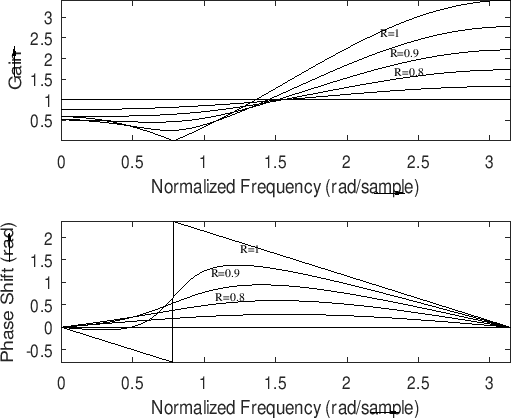![\fbox{
\begin{tabular}{rl}
Difference equation: & $y(n) = b_0 x(n) + b_1 x(n-1) + b_2 x(n-2)$\\ [5pt]
{\it z} transform: & $Y(z) = b_0 X(z) + b_1 z^{-1}X(z) + b_2 z^{-2}X(z)$\\ [5pt]
Transfer function: & $H(z) = b_0+b_1z^{-1}+b_2z^{-2}$\\ [5pt]
Frequency response: & $H(e^{j\omega T}) = b_0+b_1e^{-j\omega T}+b_2e^{-j2\omega T}$\\ [5pt]
Amplitude response: & $G^2(\omega) = [b_0 + b_1 \cos(\omega T) + b_2 \cos(2\omega T)]^2$\\
&$\qquad\qquad + [-b_1 \sin(\omega T) - b_2 \sin(2\omega T)]^2$\\ [8pt]
Phase response: & $\Theta(\omega) = \tan^{-1}\left[\displaystyle\frac{-b_1 \sin(\omega T)
- b_2 \sin(2\omega T)}{b_0 + b_1 \cos(\omega T) + b_2 \cos(2\omega T)}\right]$
\end{tabular}\vspace{10pt}
}](img1398.png)
The signal flow graph for the general two-zero filter is given in Fig.B.7, and the derivation of frequency response is as follows:
![\fbox{
\begin{tabular}{rl}
Difference equation: & $y(n) = b_0 x(n) + b_1 x(n-1) + b_2 x(n-2)$\\ [5pt]
{\it z} transform: & $Y(z) = b_0 X(z) + b_1 z^{-1}X(z) + b_2 z^{-2}X(z)$\\ [5pt]
Transfer function: & $H(z) = b_0+b_1z^{-1}+b_2z^{-2}$\\ [5pt]
Frequency response: & $H(e^{j\omega T}) = b_0+b_1e^{-j\omega T}+b_2e^{-j2\omega T}$\\ [5pt]
Amplitude response: & $G^2(\omega) = [b_0 + b_1 \cos(\omega T) + b_2 \cos(2\omega T)]^2$\\
&$\qquad\qquad + [-b_1 \sin(\omega T) - b_2 \sin(2\omega T)]^2$\\ [8pt]
Phase response: & $\Theta(\omega) = \tan^{-1}\left[\displaystyle\frac{-b_1 \sin(\omega T)
- b_2 \sin(2\omega T)}{b_0 + b_1 \cos(\omega T) + b_2 \cos(2\omega T)}\right]$
\end{tabular}\vspace{10pt}
}](img1398.png)
As discussed in §5.1,
the parameters ![]() and
and ![]() are called the numerator
coefficients, and they determine the two zeros. Using the
quadratic formula for finding the roots of a second-order polynomial,
we find that the zeros are located at
are called the numerator
coefficients, and they determine the two zeros. Using the
quadratic formula for finding the roots of a second-order polynomial,
we find that the zeros are located at

If the zeros are real [
Forming a general two-zero transfer function in factored form gives
![\begin{eqnarray*}
H(z) &=& b_0 (1 - Re^{j\theta_c} z^{-1}) (1 - Re^{-j\theta_c} z^{-1})\\
&=& b_0 [1 - 2R\cos(\theta_c) z^{-1}+ R^2 z^{-2}]
\end{eqnarray*}](img1406.png)
from which we identify
![]() and
and
![]() , so that
, so that
is again the difference equation of the general two-zero filter with complex zeros. The frequency
The approximate relation between bandwidth and ![]() given in
Eq.(B.5) for the two-pole resonator now applies to the notch
width in the two-zero filter.
given in
Eq.(B.5) for the two-pole resonator now applies to the notch
width in the two-zero filter.
Figure B.8 gives some two-zero frequency responses obtained by
setting ![]() to 1 and varying
to 1 and varying ![]() . The value of
. The value of ![]() , is again
, is again
![]() . Note that the response is exactly analogous to the two-pole
resonator with notches replacing the resonant peaks. Since the plots
are on a linear magnitude scale, the two-zero amplitude response
appears as the reciprocal of a two-pole response. On a dB scale, the
two-zero response is an upside-down two-pole response.
. Note that the response is exactly analogous to the two-pole
resonator with notches replacing the resonant peaks. Since the plots
are on a linear magnitude scale, the two-zero amplitude response
appears as the reciprocal of a two-pole response. On a dB scale, the
two-zero response is an upside-down two-pole response.
 |